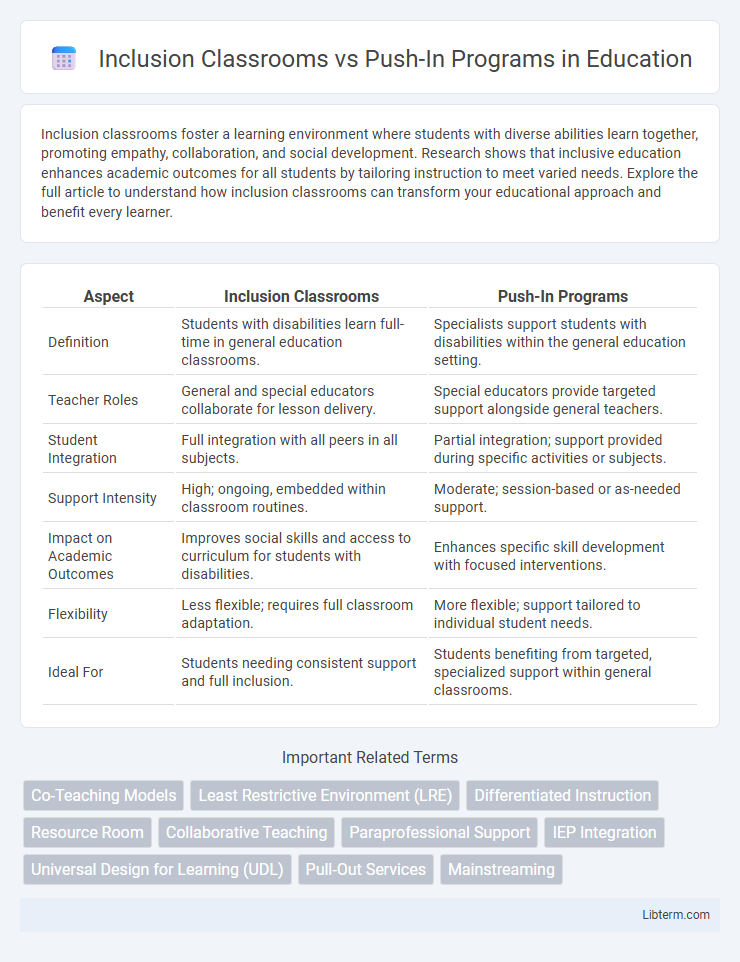Inclusion classrooms foster a learning environment where students with diverse abilities learn together, promoting empathy, collaboration, and social development. Research shows that inclusive education enhances academic outcomes for all students by tailoring instruction to meet varied needs. Explore the full article to understand how inclusion classrooms can transform your educational approach and benefit every learner.
Table of Comparison
| Aspect | Inclusion Classrooms | Push-In Programs |
|---|---|---|
| Definition | Students with disabilities learn full-time in general education classrooms. | Specialists support students with disabilities within the general education setting. |
| Teacher Roles | General and special educators collaborate for lesson delivery. | Special educators provide targeted support alongside general teachers. |
| Student Integration | Full integration with all peers in all subjects. | Partial integration; support provided during specific activities or subjects. |
| Support Intensity | High; ongoing, embedded within classroom routines. | Moderate; session-based or as-needed support. |
| Impact on Academic Outcomes | Improves social skills and access to curriculum for students with disabilities. | Enhances specific skill development with focused interventions. |
| Flexibility | Less flexible; requires full classroom adaptation. | More flexible; support tailored to individual student needs. |
| Ideal For | Students needing consistent support and full inclusion. | Students benefiting from targeted, specialized support within general classrooms. |
Introduction to Inclusive Education
Inclusive education promotes equal learning opportunities by integrating students with diverse abilities into general classrooms, enhancing social interaction and academic participation. Inclusion classrooms offer a seamless environment where students with disabilities learn alongside peers, fostering acceptance and collaboration. Push-in programs provide specialized support within the general classroom, allowing targeted assistance while maintaining full inclusion.
Defining Inclusion Classrooms
Inclusion classrooms integrate students with disabilities into general education settings, promoting equal participation alongside peers without disabilities. These classrooms provide tailored supports and accommodations within the standard curriculum to meet diverse learning needs. Emphasizing social interaction and collaborative learning, inclusion classrooms foster an inclusive environment that benefits all students.
Understanding Push-In Programs
Push-in programs integrate special education services within general education classrooms, allowing students with disabilities to receive support without leaving their peers. This model promotes collaboration between general and special education teachers to tailor instruction to diverse learning needs. The push-in approach enhances social inclusion and academic engagement by providing timely interventions in the natural learning environment.
Key Differences Between Inclusion and Push-In
Inclusion classrooms integrate students with disabilities into general education settings, promoting full participation and tailored supports within the core curriculum. Push-in programs involve specialists entering the general classroom to provide targeted interventions without removing students, ensuring individualized assistance within the regular environment. The primary difference lies in the level of integration: inclusion fosters a fully inclusive setting, while push-in focuses on supplemental support within mainstream classes.
Benefits of Inclusion Classrooms
Inclusion classrooms promote social integration by enabling students with disabilities to learn alongside their non-disabled peers, fostering empathy and diverse perspectives. They enhance academic outcomes through differentiated instruction tailored to individual needs within a collaborative setting. Access to inclusive environments improves communication skills and builds a sense of community, supporting overall student development and peer relationships.
Advantages of Push-In Programs
Push-in programs enhance student learning by integrating specialized support within the general education classroom, promoting collaboration between special education and general teachers. This approach fosters social inclusion and reduces stigmatization by keeping students with disabilities in their mainstream environment. Access to immediate, tailored assistance boosts academic performance while encouraging peer interaction and differentiated instruction.
Challenges in Implementation
Inclusion classrooms face challenges such as limited teacher training and inadequate resources to support diverse learning needs effectively. Push-in programs often struggle with scheduling conflicts and insufficient collaboration between special education and general education staff. Both models require careful planning and professional development to overcome barriers and ensure meaningful student engagement.
Impact on Student Achievement
Inclusion classrooms promote higher academic achievement by integrating students with disabilities into general education settings, fostering peer interaction and access to the same curriculum. Push-in programs provide specialized support within the general classroom, allowing for targeted interventions without removing students from their peers, which helps maintain continuity in learning. Research shows that both approaches improve student outcomes, but inclusion classrooms often yield greater gains in social skills and overall academic performance.
Teacher Roles and Collaboration
Inclusion classrooms require teachers to adapt curriculum and instruction to meet diverse learner needs while fostering an inclusive environment, emphasizing differentiated teaching and proactive classroom management. Push-in programs highlight collaboration between general education teachers and special education specialists working simultaneously to support students with disabilities, facilitating co-teaching and real-time instructional adjustments. Effective partnerships enhance student engagement and learning outcomes by leveraging the complementary expertise of all educators involved.
Choosing the Right Approach for Schools
Inclusion classrooms integrate students with disabilities directly into general education environments, promoting social interaction and differentiated instruction, while push-in programs provide specialized support within the mainstream classroom without full integration. Schools must evaluate factors such as student needs, staff expertise, resource availability, and class size to determine which approach maximizes academic outcomes and social development. Data-driven decision-making and collaboration among educators, parents, and specialists are essential to selecting the most effective model for diverse learner success.
Inclusion Classrooms Infographic

 libterm.com
libterm.com